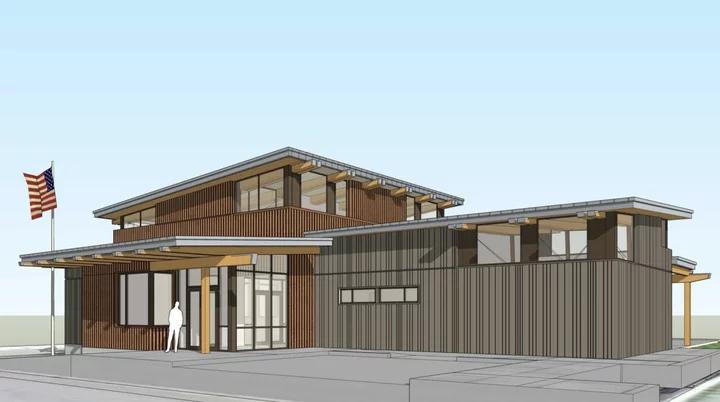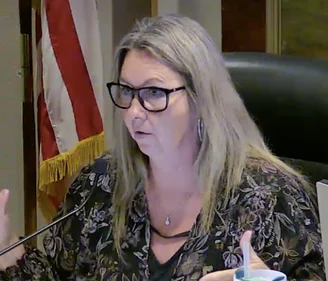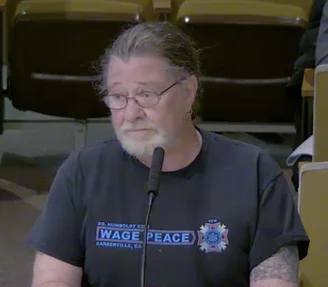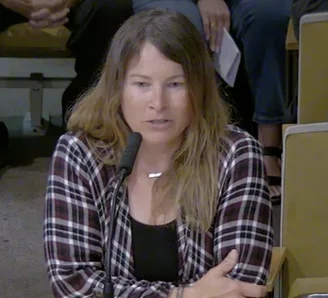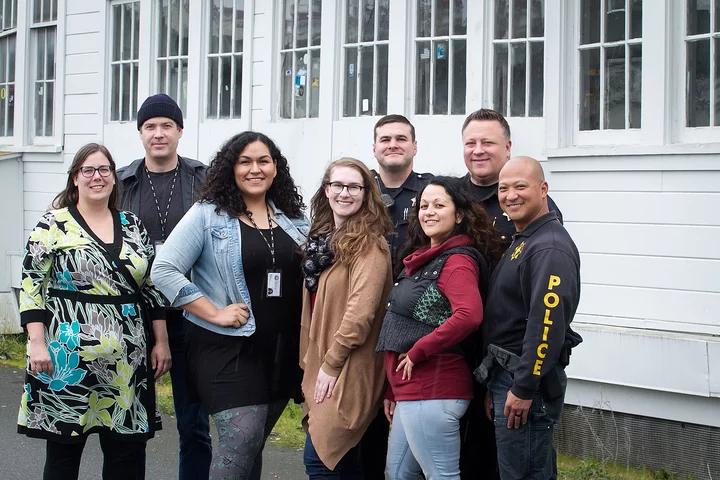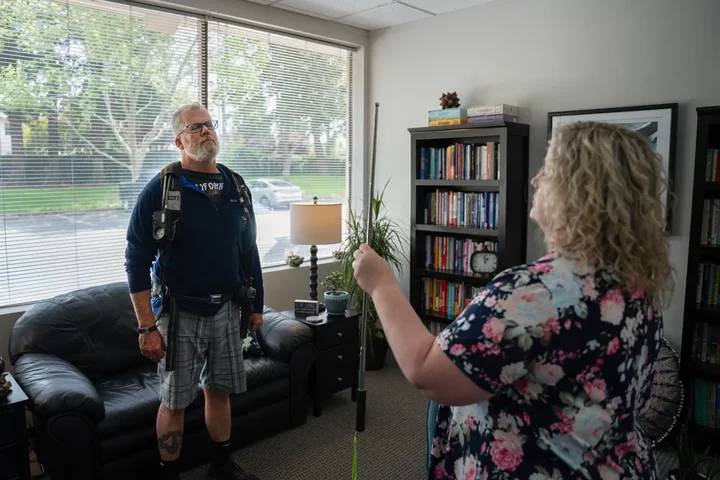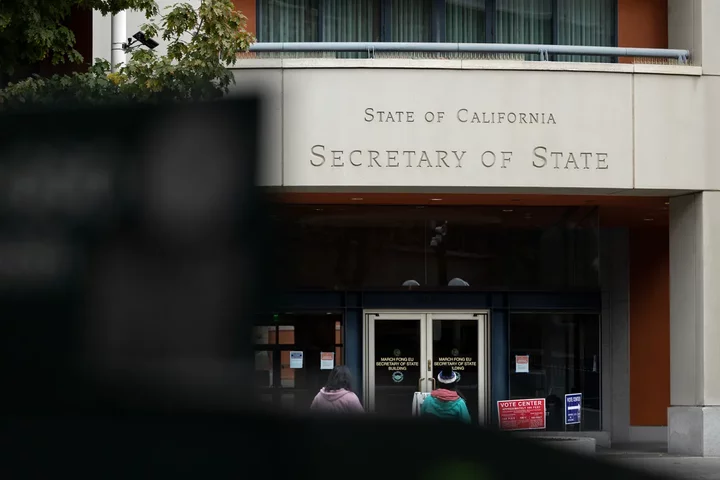YESTERDAY IN SUPES: Board OKs Another $3.5 Million for New Garberville Vets Hall Despite Ongoing Financial Woes; HCSO Settles Contract Dispute with Blue Lake
Isabella Vanderheiden / Wednesday, June 26, 2024 @ 3:10 p.m. / Local Government
Screenshot of Tuesday’s Humboldt County Board of Supervisors meeting.
###
Following two hours of tense deliberation and emotional public commentary from local veterans, the Humboldt County Board of Supervisors voted 4-1, with Third District Supervisor Mike Wilson dissenting, to approve long-awaited design plans for a new veterans hall in Garberville.
The John Haynes Memorial Veterans Hall, which also housed the Southern Humboldt branch of the county courthouse, was shuttered in May of 2016 after county inspectors found black mold growing in the walls and ceiling, along with other structural issues, following years of deferred maintenance. The building sat for years before, in June of 2021, the Board of Supervisors voted to demolish and reconstruct a slightly smaller version of the original building.
The board entered into a contract with Medford-based architectural firm ORW Architecture, Inc. to design a new veteran’s hall. Speaking at this week’s meeting, Sean Meehan, the county’s deputy director of facilities management, informed the board that costs have increased “significantly” since the plans were initially approved in 2021. At that time, demolition and construction costs were estimated at $3.08 million. The original design would require another $3.57 million in additional funding.
“We immediately set to work with the design team on ways that we could modify the design, reduce the cost significantly but not impact the quality substantially,” Meehan said. ORW got to work on another, less complex design – as seen below – that reduced the footprint of the building by 220 square feet and cut the price tag by about $1.2 million. “One of the biggest cost-saving techniques that we used [in the second design] is a great simplification of the roof structure … the overall building is about six- to six-and-a-half feet lower than the previous building. There’s just less material overall.”
Original rendering. Image: ORW Architecture, Inc.
Revised rendering. Image: ORW Architecture, Inc.
Following staff’s presentation, Second District Supervisor Michelle Bushnell asked where the additional funding would come from. County Administrative Officer Elishia Hayes said the county’s finance plan would be the “best funding source” for the project, but said most of the funds are already spoken for.
“We are currently under the 2020 Finance Plan, and that is by and large already committed,” Hayes continued. Most of that funding was set aside for the county’s jail expansion and rehabilitation project, but the plan was scrapped a few months ago due to funding constraints. “That does relieve some capacity but … we did repurpose some of those for projects that were needed in the jail. … That leaves approximately $1.4 million [that is] still available.”
Staff is working on a 2024 Finance Plan that could potentially provide funding for the new veteran’s hall. However, Hayes noted that there are “a lot of infrastructure projects on the table for the county” that would pull from the same pot of funds.
“We’ve procured a number of properties and are diligently working on … our Facilities Master Plan and starting to get some big things underway,” she said. “That is our biggest and most fruitful funding mechanism to move those things forward.”
Bushnell acknowledged the county’s “financial dilemma” but spoke in favor of the original, more expensive design preferred by veterans.
“I’m not passing blame, but had we taken care of the facility we had – which is a problem we have in all of our [county] facilities – we wouldn’t be here at this point,” she said. “[The veterans] would have their original hall – which is what they wanted, they didn’t want a new hall – and now they have nothing. I really hope that this board can be supportive [of this project]. I know that, you know, our budgets are not great, but there is money in the finance plan that we can allocate to this, and already did in 2021.”
Bushnell also asked when construction would begin. Meehan said it would depend on which option the board selected, noting that option one “is the most developed” and would allow for “the quickest turnaround.”
“I don’t think it would take a huge amount of time and effort and cost to get option two to that same level,” he continued. “I think it would be … an extra month or two to get option two to where option one is.”
Looking past specific design criteria, First District Supervisor and Board Chair Rex Bohn urged staff to set up an arrangement with Southern Humboldt veterans that would allow them to work on the building as needed to avoid a repeat of the current situation.
“I think what we need to do is allow the veterans to do some of this work, rather than holding a fist and say[ing], ‘nope, we have to do that work’ and then we don’t do it,” he said. “I think they understand the constraints, [but] I think what we have to do is we have to change the way we do business on these things … especially if we’re looking at $7 million, here. It’s gonna be over $7 million by the time we’re done because construction costs are still going up.”
Fourth District Supervisor Natalie Arroyo, a veteran of the U.S. Coast Guard, acknowledged the longstanding issues surrounding the Garberville Veteran’s Hall but, like Hayes, noted that many county facilities need attention.
“We also are in a position of trying to get county buildings and facilities serviceable for more of our own employees to work in so that we can stem the flow of funds to extremely expensive leases and lease agreements … that are ultimately costing folks in the community, you know, through the county a lot of money,” she said. “[E]very single county office you go to has facilities needs in the queue. It’s, it’s just a lot. It’s sobering.”
Bushnell thanked Arroyo for her comments but pushed back, asserting that it is “the responsibility of this county to provide them [with] a facility … .”
“I know the money’s very tight and that we were in a terrible crunch, but if we kick this can down the road again it’s not going to be cheaper next year or the year after,” Bushnell continued. “I’m fearful that they’ll never get their facility, and that’s not okay in my book and it shouldn’t be okay in your books.”
Third District Supervisor Mike Wilson noted the “trajectory of vacancies” in Southern Humboldt and asked if staff had looked into buying a vacant commercial space rather than building something brand new.
“I have a concern that we’re moving forward with building a new structure in an area where we’re already seeing structures that aren’t being used enough to sustain their life or in that community,” Wilson said. “I’m just having some anguish about that. … I mean, I went to the original [vets hall] as a kid … and all the cool stuff that happened there, that’s real and should happen again. … We’re just in this spot with our budget [and] we’re hitting a wall.”
Wilson asked how much the project would cost the county on an annual basis. At an estimated five percent interest rate, Hayes said the county would make an annual payment of $340,000 - $380,000. “Over the life of a 30-year amortized loan, that would … significantly increase the cost overall,” she said. “It would double it by the time we paid the interest over a 30-year time period.”
“Can you say that number out loud? What is that doubling number?” Wilson asked.
“Well, for option one – making an assumption of a 5 percent interest rate – it would be roughly $11.6 million,” Hayes said. “Option two [would be] $10.2 million.”
Fifth District Supervisor Steve Madrone expressed some of the same concerns as Wilson and Arroyo, adding that county facilities are “in really horrible shape” with “tiles falling out of the ceiling on the desks, literally as we speak.”
“We’re gonna have to start laying off staff, that means less road crews, less social service employees and all kinds of things,” he continued. “If we put too many eggs in this basket, we [will create] the very same thing that created this situation, and that’s not a solution. That’s not helping out by putting too much money into something that then causes all of our other facilities to fall into further disrepair.”
The board floated a few other ideas that could bring in additional funding, including contacting Congressman Jared Huffman’s Office and prospective donors for support. Madrone suggested that the county look into “modular” building strategies that would give staff more time to hunt down potential revenue streams.
During public comment, more than a dozen veterans and supportive community members urged the board to move forward with one of the designs, ideally the original plan. Many of the speakers criticized the county for failing to address longstanding issues at the old building, which led to this whole mess. Some said the vets hall served as “a home away from home.”
“When I lost my hall eight years ago, it felt like I lost my home,” said Tom Pietila, a former commander of the Garberville VFW. “Please, do not delay like you did before.”
Doug Battles, another former commander of the Garberville VFW, noted that war has persisted internationally since the veteran’s hall was shuttered eight years ago. In that time, many young veterans have returned home with no place to go. “There is no community left, except for the older guys,” he said. “Are you going to go into a meeting at a senior citizen’s center in order to help your community? I mean, these young guys are not going to come in and do that stuff.”
Battles criticized the county for “kicking the can” and failing to contact elected officials like Huffman. “It’s been eight years, why didn’t you reach out before?” he asked. “I wrote to Huffman last night in an email. Boom, done. He knows the problem. Did you guys think about doing that?”
The criticism went on for about a half hour, with some people shaming the board for failing to take action and one commenter saying he felt “sick to [his] stomach” over the whole ordeal. Many speakers were understanding of the county’s budgetary woes but ultimately felt the county owed veterans a new facility.
Following public comment, Bushnell made a motion to approve the original design plan, which was seconded by Arroyo. The board deliberated for another half hour, discussing funding alternatives and other ways to save money on the project. Bushnell added an amendment to the motion that directed to contact state and federal representatives for potential grant funding. She said she would reach out to local folks as well.
The motion passed 4-1, with Wilson dissenting.
HCSO Services in Blue Lake
Earlier in the meeting, the board settled a contractual dispute between the Humboldt County Sheriff’s Office and the City of Blue Lake over the cost of law enforcement services. The item was pulled from the board’s consent calendar by Wilson, who expressed concern that the county was attempting to “claw back” money from the city.
“In the simplest terms, there was a contract for services [with] the sheriff for Blue Lake and … about a year-and-a-half ago, the sheriff made a request to the City of Blue Lake to adjust those charges,” Wilson explained. “There had been a negotiation … it was tense but they worked through it to negotiate the next contract. [Now], the sheriff is requesting to modify the existing contract so that there is a retroactive cost that goes back to the city. I disagree with that.”
Humboldt Sheriff William Honsal explained that the item before the board seeks to clarify language in staff’s recommendation that was approved with the original contract in May of 2024. Basically, the agenda item set a cap on the cost of law enforcement services that has “created some confusion” between HCSO and the city.
“We have a signed contract which gives us the ability to recalculate our costs every year if our costs go up,” he said. “We have that ability, within our signed contract … that gives us that ability to charge the real costs of providing professional services to Blue Lake. Where [the city] is pushing back is, in the original agenda item, there was basically a $327,000 cap that was going to be utilized for this contract, and that’s not the case.”
The contract was written to include a minimum charge for law enforcement services each year and allow HCSO to adjust that figure accordingly, Honsal explained. “Over the last three years, our costs have gone up dramatically. Liability insurance, the cost for a deputy raises, and just inflation in general.”
For example, around the time the contract was signed in 2022, HCSO informed the city that the cost of services had increased from $122,876 to $146,450 for the 2022-23 fiscal year, according to the staff report. The city did not dispute the charge at the time and the amount was paid in full.
However, in May of 2023, HCSO informed the city that the annual charge for services would increase from $146,450 to $315,656 in the 2023-24 fiscal year. “The [city] paid the first quarter in the amount of $78,914, and subsequently appealed the annual amount,” the staff report states. “In good faith, HCSO has met with the [city] and has negotiated changes to the calculation methodology resulting in the amount being recalculated to $190,685.”
That adjusted rate means the city owes HCSO roughly $45,000 in retroactive payments, according to the staff report.
Speaking before the board, City Manager Amanda Mager disputed the additional charge and called HCSO’s methodology into question.
“It’s $45,000 that the City of Blue Lake doesn’t really have [because] it wasn’t something we budgeted for. It wasn’t something that we even knew coming down the pike,” Mager said. “I think at this point, we’ve probably all expensed more than $45,000 in staff time, review, anxiety and stress in our communities. It would just be nice to move forward … with a clean new contract.”
Speaking during public comment, Blue Lake City Councilmember Elise Scafani, noting that she was not speaking on behalf of the council, said she felt as though the city “was granted absolutely everything we asked for” during its negotiations with HCSO. She noted that Blue Lake pays less for law enforcement services, per capita, than any other municipality in the county. On top of that, she said the city had a budget surplus last year, so there was money available.
“What I can’t understand is why we’re not willing to pay for the service for the current fiscal year,” she said. “I feel that the city has the money [and] that the city was aware of the process. … The sheriff invited the city to talks over and over and over again, and those talks didn’t happen until January. I feel that the city is just simply in a position where we need to say, ‘Hey, we got everything we needed out of these talks, and it’s just time to write the check and move forward.’”
During board deliberations, Wilson said he felt HCSO should have addressed the monetary dispute with the city early on. Bohn suggested they meet the city in the middle and charge $162,000 rather than $190,000, which Wilson said he would support.
However, Honsal said negotiations were no longer on the table.
Bushnell agreed and made a motion to approve staff’s recommendation to amend the old staff report and charge the city $45,000 in retroactive payments. The action was seconded by Arroyo and passed 4-1, with Wilson dissenting.
###
Check out yesterday’s meeting coverage here.
BOOKED
Today: 3 felonies, 9 misdemeanors, 0 infractions
JUDGED
Humboldt County Superior Court Calendar: Friday, Dec. 26
CHP REPORTS
US101 N / HUMBOLDT HILL RD ONR (HM office): Traffic Hazard
2600 Mm199 N Dn R26.00 (HM office): Traffic Hazard
Low Divide Rd / Sr197 (HM office): Trfc Collision-1141 Enrt
ELSEWHERE
Washington Post: Every family has a history. Here’s how to make sure it’s handed down.
The Hill: Will marijuana be legalized, rescheduled in 2026?
The Guardian: Brigitte Bardot, French screen legend, dies aged 91
League of Women Voters Chimes in on Lack of Transparency in Eureka City Schools Property Transfer
Gillen Tener Martin / Wednesday, June 26, 2024 @ 12:23 p.m. / Education
The Jacobs Campus. File photo: Andrew Goff.
The League of Women Voters of Humboldt County (LWVHC) has entered the chat on the alleged lack of transparency around the Eureka City Schools (ECS) Board of Trustees action on one now-notorious property swap.
At the Board’s regularly scheduled meeting yesterday, the first since Humboldt County’s Civil Grand Jury released a report slamming the “secretive” nature of the Trustees’ decision making in the Jacobs Campus deal, LWVHC Board Member Anne Hartline read a three-minute excerpt from the League’s statement.
“We were shocked and concerned by the actions of the ECS Board of Trustees on December 14, 2023 when it approved a major real estate transaction with minimal public notification or community input,” the statement reads.
The action in question is, of course, the Board’s Dec. 14 decision to exchange the site of the former George C. Jacobs Junior High School for a small residential property and $5.35 million – entering into a partnership with the AMG Communities-Jacobs, an LLC that was formed just days before.
“The bottom line for us is transparency,” Hartline told the Outpost regarding the League’s decision to weigh in, “we believe that all members of the public should be given opportunity by elected boards to learn, voice opinion and engage in their communities.”
“And we believe this action did not have adequate transparency,” she concluded.
The statement came the same week that some Eureka residents received a mailer from the Housing for All and Downtown Vitality Initiative, sponsored by Rob Arkley’s Security National Properties Holding Company, LLC, which outlines a vision of what the Jacobs site could be – despite the claim on AMG Communities’ frequently asked questions page that Arkley is “not an owner or investor” in the LLC.
LWVHC clearly wants the details on that, as one of their (five) suggestions to the Board was to “disclose the names of all partners in AMG Communities-Jacobs, LLC to establish the bona-fide identity of its members and disclose its financial integrity.”
Because the topic was not agendized for the June 25 ECS Board of Trustees meeting, the trustees could not respond to LWVHC’s statement due to Brown Act regulations. The Board did say that it will respond to the Grand Jury’s findings within 90 days of the report’s June 12 release in one of its regularly scheduled meetings.
The property transfer is on tomorrow’s 6:30 p.m. ECS Board meeting as a closed session item. The meeting agenda can be found here.
Read the full text of the League’s statement below.
To: Eureka City Schools Board of Trustees
Dear Trustees;
The League of Women Voters, a nonpartisan political organization, encourages informed and active participation in government, works to increase understanding of major public policy issues, and influences public policy through education and advocacy. The League is nonpartisan in that it does not support or oppose any political party or candidate; it is political in that it takes positions on selected governmental issues after member study and agreement.
One such member study was conducted by the League of Women Voters of Humboldt County (LWVHC) in 2016. The study, which is part of the LWVHC Government Portfolio and is entitled “Civic Engagement”, specifically states that:
All governmental bodies and organizations should:
- Facilitate equitable access to current information about all public meetings open or closed. This shall include all information about the meetings, agendas, and reports. This information should be made accessible to the public with reasonably sufficient time for citizen response and/or input.
- Ensure that equitable opportunities exist for public input from multiple platforms and provide ample opportunities for citizens to participate in the civic process,
- Ensure that sufficient input from citizens is allowed at public meetings and recorded in the minutes
- Ensure transparency for citizens about all policies, practices, evaluations, and decisions of the organization.
The League of Women Voters of Humboldt County feels very strongly about the need for full and open transparency, as well as opportunities for citizen involvement related to the actions of elected governmental boards and governmental decision-making.
For this reason, we were shocked and concerned by the actions of the Eureka City Schools Board of Trustees on December 14, 2023 when it approved a major real estate transaction with minimal public notification or community input. Our concerns were validated by the recent Humboldt County Civil Grand Jury Report released on June 12, 2024.
The League of Women Voters of Humboldt County strongly agrees with the Grand Jury’s summary (page 1): “The Humboldt County Civil Grand Jury concludes that the Eureka City Schools Trustees acted hastily and without sufficient due diligence. While apparently literally complying with the technical requirements of the California Government Code (Brown Act) with respect to a real estate transaction, the Trustees violated the law’s general intent for public participation and transparency in decision-making.”
We also concur with the Deficiencies cited in the report (pages 9 and 10): “There was insufficient time for the ECS Trustees and the public to read, understand, and openly discuss and question the pending deal.”
We were additionally shocked to learn that:
- “Although the ‘agenda packet’ distributed to ECS Trustees approximately 72 hours before the December 14, 2023, meeting included the draft resolution and agreement (17 pages single-spaced), these documents were not available to the public. The publicly announced agenda at the time did not specify the details of the pending transaction.”
- “Prior public notice did not inform that the pending deal involved not just a sale of surplus property but a property exchange bypassing certain provisions of the Education Code.”
- “ECS Trustees did not publicly verify the bona fide identity and finances of AMG Communities-Jacobs, LLC.”
In terms of the Grand Jury report’s statement regarding Due Diligence and Decision-making (pages 10 and 11), the League of Women Voters of Humboldt County agrees that:
- “The public has a right to be informed about pending decisions, to be involved, and to fully participate.”
- “The ECS Trustees did not exercise due diligence and did not inquire about the resolution agreement.” “…On December 14, 2023, the ECS Trustees in effect “rubber-stamped” the Resolution and Agreement.”
And finally, the League of Women Voters of Humboldt County concurs with the Grand Jury report’s statement on Decision-making (page 12): “ECS Trustees, administrators, and advisers did not provide sufficient information regarding the agendized Jacobs property transaction at least 72 hours prior to ECS Trustee action, thereby preventing meaningful public participation in the enactment of the Resolution and Agreement.”
The League of Women Voters of Humboldt County strongly suggests that the Eureka City Schools Board of Trustees take the following actions to address the concerns raised in the Humboldt County Civil Grand Jury report and restore transparency to this important transaction between ECS and AMG Communities-Jacobs, LLC:
Immediately make the details of the Jacobs property negotiations and ongoing status of the transaction known to the public,
Fully disclose the names of all partners in AMG Communities-Jacobs, LLC to establish the bona-fide identity of its members and disclose its financial integrity,
Fully explain the need felt by ECS Board of Trustees, the Superintendent and advisers for the “secretive, last-minute, quick judgment, in an intentionally compressed time-period, without public knowledge, behind closed doors”. (Grand Jury Report Conclusion, page 12)
Now, and in the future, “provide the public with an opportunity to be informed and to question the details of this decision and its potential relationship to other local public policy issues.” (Grand Jury Report Findings, page 13)
Delay the close of escrow on this transaction to allow adequate time to address Items 1-4 above.
Sincerely,
Dr. Sharolyn Hutton, LWVHC Co-President
Jessica Schlachter, LWVHC Co-President
Anne J. Hartline, LWVHC Board Member
Grand Jury Takes Deep Dive on Humboldt County’s Mental Health Crisis Street Teams
LoCO Staff / Wednesday, June 26, 2024 @ 11:11 a.m. / Local Government
The MIST team in 2017. File photo via DHHS.
DOCUMENT:
###
Press release from the Humboldt County Civil Grand Jury:
The Humboldt County Civil Grand Jury has released the seventh report of their 2023-2024 term, entitled “Humboldt County, Behavioral Health, Substance Use, and the Streets: What Works?” Humboldt County citizens who are suffering from significant behavioral health issues have few options. If they are fortunate enough to have private insurance, they may be able to find treatment from a private psychiatrist, nurse practitioner, or clinician. If they need to be hospitalized, they may be able to go to an out-of-area private in-patient facility. For the unhoused, uninsured, underinsured, and those individuals in active and severe crisis, those options do not exist.
For many years the primary responders for our citizens suffering active behavioral health crisis have been law enforcement. This situation is not by choice, but they are often the last strings in the social safety net. In the last fifteen years or so officers have slowly obtained more tools, usually through Critical Incident Team training. These training tools assist law enforcement officers to recognize people in crisis, to use effective de-escalation techniques, and to coordinate with trained behavioral health professionals that respond to assist or manage the situation when they are available.
This report focuses on the concept of having trained professionals to work with those individuals in crisis. Over the last decade, two programs have been reaching out to those most in need. These programs are the Mobile Intervention and Services Team (MIST) and Crisis Alternative Response Eureka (CARE). CARE often works with the Eureka Police Department’s Community Safety Engagement Team (CSET). However, it is important to note that these programs are not aimed solely at those in crisis. These programs also address substance use disorder and attempt to identify people before they reach behavioral health crisis. These programs work to connect the most marginalized of our citizens with critical resources while treating them with respect and dignity.
The 2024-2025 term for the Civil Gand Jury is right around the corner, and the Superior Court is seeking more jurors. If you want to serve your community in a unique way that could improve local government this is your opportunity. Applications to serve on the Humboldt County Civil Grand Jury can be found at this link. Additional information provided by the Civil Grand Jurors Association of California can be found at this link.
‘Excruciatingly Slow’: Delays in Workers’ Comp Payments Harm Firefighters, Frustrate Therapists
Julie Cart / Wednesday, June 26, 2024 @ 8:11 a.m. / Sacramento
Retired Cal Fire Captain Todd Nelson and his therapist, Jennifer Alexander, conduct a “brainspotting” exercise as part of his treatment that involves Nelson wearing firefighting equipment. Photo by Cristian Gonzalez for CalMatters
With a diagnosis of complex post traumatic stress disorder and wracked by frequent anxiety-induced seizures, Cal Fire Captain Todd Nelson spends much of his days in acute mental distress. His therapist, Jennifer Alexander, said “nine out of ten therapists wouldn’t touch Todd with a ten-foot pole.”
Why? Because of the challenge of treating a firefighter with such a severe mental health condition, including multiple suicide attempts and hospitalizations?
No. Because California’s therapists know that taking on a patient in the state’s workers’ comp insurance system means that it could be years before they are paid. In addition, it’s likely that insurers would challenge their treatment decisions and even subpoena their records.
“If you take a work comp case you knowingly understand that you are not going to get paid for some time,” said Alexander, a licensed marriage and family therapist who specializes in treating PTSD and trauma. Nelson granted her permission to talk about his case. “I have multiple cases in which I haven’t been paid for three years. You have to have a passion to work with this population,” she said.
The intransigence of the system puts doctors in a difficult position — deny patients the care they need or forego their own payment. Like many therapists who fear the impacts of cutting off treatment to seriously ill firefighters, Alexander treats many of them anyway. Then she figures out later how to get reimbursed.
“You have to make a moral-ethical decision — to make a commitment to a client or a commitment to getting paid,” she said. “Insurance gives you a handful of sessions, but with many patients,” like Nelson, “trauma is not going to be resolved in ten to twelve sessions.”


Therapist Jennifer Alexander and her patient, former Cal Fire Captain Todd Nelson, at a therapy session. Alexander says the workers’ comp bureaucracy deters many therapists from treating first responders with PTSD. Photos by Cristian Gonzalez for CalMatters
Some doctors simply refuse to take workers’ comp cases, leaving fewer choices for firefighters and other patients with PTSD and other serious ailments. And a potentially crushing caseload for therapists.
The state’s workers’ compensation system, managed by the California Department of Industrial Relations, provides benefits for private and government workers whose medical conditions are work-related. More than 16 million Californians are covered.
Officials from the industrial relations department refused to answer CalMatters’ questions or provide an interview about issues related to first responders’ mental health claims.
California workers’ comp is an outlier, and not in a good way.
“California continues to experience longer average claim duration compared to other states, driven by slower claim reporting, lower settlement rates and higher frictional costs,” says a 2023 report by the Workers’ Compensation Insurance Rating Bureau, an association of companies licensed to handle workers’ comp insurance in the state.
Only a third of medical losses in California are paid by workers’ comp within two years of an injury, while it’s two-thirds in other states. And about 36% take five years or longer in California, about twice the median in other states, according to the report.
California’s sheer size slows the rate of case closure and reimbursement, said Sean Cooper, executive vice president and chief actuary for the Workers’ Compensation Insurance Rating Bureau. The torrent of claims, the number of attorneys in the system and the complexity of trauma cases bog down an already ponderous bureaucracy.
Because of their cumulative trauma that can stem from an entire career, they often need years of therapy.
Some therapists no longer accept workers’ comp or even private insurance, leaving a patient paying fully out of pocket for mental health care, said D. Imelda Padilla-Frausto, a research scientist at the UCLA Center for Health Policy Research.
“Clinicians often go into private practice because they don’t want to deal with even health insurance. It’s all out of pocket. Then you add workers’ comp on to that, and it’s “oh, no,’ ” she said. “Our health system is administration-heavy.”
Nelson ran smack into that bureaucratic wall. He said he contacted therapists who refused to take insurance or were intimidated by the severity of his diagnosis. “They were being polite, telling me they weren’t taking new patients,” he said.

Nelson, who lives in Nevada City, searched for years for a therapist that would take his case. Experts says there aren’t enough therapists in many rural regions. Photo by Cristian Gonzalez for CalMatters
RAND researchers noted many of these shortcomings in California’s workers’ comp system in a 2021 report.
“The workers’ comp system is excruciatingly slow, doctors are annoyed, not getting paid for extra reports and patients are not getting care,” said Denise D. Quigley, senior policy researcher at RAND and one of the report’s project leaders.
Previous research had identified problems with California’s workers’ comp system, including a heavy burden of administrative costs borne by providers, who also complained about inadequate compensation.
“It’s hard to find providers willing to take on the struggle for workers’ comp. There are some that will just take patients outright, but a majority can’t,” Quigley said. “They recognize that if they take them on there will be self pay, it’s months to get paid, and unless they are part of a really large organization, they can’t cover that cost.”

Nelson recalls traumatic memories of his time as a firefighter during a treatment session. Photo by Cristian Gonzalez for CalMatters
Frustration is winnowing the ranks of providers qualified to treat PTSD and related issues, according to Joy Alafia, executive director of the professional group California Association of Marriage and Family Therapists.
“We have a shortage of mental health professionals overall in California, and with the added paperwork and denials…you can understand why there is a natural inclination to choose a different path. The administrative burden is so great, you need assistance and technology to help overcome the barrier,” Alafia said.
In four years, the demand for mental health care in California will exceed the workforce capacity, according to a UC San Francisco analysis.
Alafia said the administrative burden from workers’ comp sometimes forces therapists to bring on more staff to “wrestle with companies” that reject what doctors view as a sufficient number of patient visits.
That can leave patients vulnerable, Alafia said, which is an unconscionable bottom line.
“We have concerns about continuity of care,” she said. “The more time marriage and family therapists spend doing paperwork means less time with the client. And that’s what people get into this profession to do in the first place.”
###
This story was made possible in part by a grant from the A-Mark Foundation.
CalMatters.org is a nonprofit, nonpartisan media venture explaining California policies and politics.
The Effort to Bring Back Affirmative Action in Limited Form Is Dead
Mikhail Zinshteyn / Wednesday, June 26, 2024 @ 8:03 a.m. / Sacramento
The Secretary of State building in Sacramento on Nov. 7, 2022. Photo by Miguel Gutierrez Jr., CalMatters
A proposed California constitutional amendment to permit some aspects of affirmative action won’t appear on the ballot this year because its author feared voters wouldn’t pass the measure — but he also vowed to bring the proposal back for a future state election.
The measure, known as Assembly Constitutional Amendment 7, would not have fully overturned Proposition 209, which state voters passed in 1996 and created the country’s first ban on racial preferences, including affirmative action in public university admissions. Instead, it sought to allow state agencies to send the governor a waiver request to sidestep some of Proposition 209’s restrictions if academic research showed those programs would improve the health, economic or educational outcomes of specific demographic groups.
An effort to undo Proposition 209 was voted down by Californians in 2020.
The proposed amendment was one of 14 priority legislative efforts this year backed by the California Legislative Black Caucus. Those were informed by a state-funded reparations task force report that included more than 100 financial and legal recommendations to combat the legacy of slavery and racism in California.
There are “so many propositions sucking up additional financial resources,” said the measure’s author, Corey Jackson, an Assembymember and Democrat from Moreno Valley, in an interview with CalMatters this evening.
He also cited concern that an anti-crime measure that’s currently on the November ballot will attract fierce opposition to his measure — and to another effort by his peers in the Black Caucus to end forced labor in California prisons. The fundraising challenges to fight one measure and back two others prompted members of the Black Caucus to call off ACA 7 late last week, Jackson said.
As recently as a week ago, his office was signaling that it would push to place the measure on this year’s November ballot by meeting a Thursday deadline for ballot proposals to pass the Legislature. Any constitutional proposal from a lawmaker must pass both chambers of the Legislature, but doesn’t require the governor’s signature.
“He’s (Jackson) still confident he’s going to meet the deadline,” his spokesperson told Calmatters last Wednesday. While the measure cleared the Assembly last year, it languished in the Senate until receiving committee assignments only last week.
Jackson said Tuesday that “there was no doubt in our minds we were going to get it out of the Legislature. The question is: Should we?” Jackson said Democratic leadership supported the proposed amendment.
“The question is when is the right time to do it? Is it 2026? Is it 2028?” Jackson asked. “We have to see where we are in terms of the predictability of our electorate and turnout, as well as what type of political climate we’re in.”
Wenyuan Wu opposed Jackson’s measure. She’s executive director of the Californians for Equal Rights Foundation, a group that opposes race-based interventions because it views such efforts as discriminatory. Wu and other foundation officials played major roles in successfully campaigning against Proposition 16 in 2020.
“We’re very happy that the assemblyman has come to this realization,” Wu said this evening in an interview. It was “not going to be received well on the ballot,” she predicted.
It’s also unclear if a measure like Jackson’s would pass federal court scrutiny given the U.S. Supreme Court’s ban on affirmative action, a legal scholar told CalMatters last year.
###
CalMatters.org is a nonprofit, nonpartisan media venture explaining California policies and politics.
OBITUARY: Shannon Randoll Filgas, 1978-2024
LoCO Staff / Wednesday, June 26, 2024 @ 6:56 a.m. / Obits
It’s with great sadness and heavy hearts that our family give
notice of the passing of Shannon Randoll Filgas. He departed this
world on June 12, 2024 at 10:25 p.m. at Post Sonoma acute in Sonoma.
He will be cremated by Duggan’s Mission Chapel in Sonoma and be
able to come home forever. Shannon was 46 years old and was born on
February 17, 1978 at old general hospital in Eureka, to Donna Maxwell
and Randall Filgas.
Shannon was preceded in death by his father Randall Lynn Filgas, grandfathers Milton James Filgas, Fred Holt, grandmothers Amelia Kimson, Barbra Deckert, great-grandmother Irene Patterson, great-grandfathers Henry Patterson (Bio), Clyde Patterson (adopted), cousin Randall Flesher, great-aunts Loretta and Heneryetta Patterson, great-uncle James Patterson (AKA uncle Butch) and Velma Patterson his wife. Also his father figure through out his life Donald Hill.
People have lots of different memories of Shannon, like when he drug Curtis’s dad down the road on a three-wheeler. How certain people can remember and tell me how excited, frantic and worried you were the day I was born, running around the hospital telling everyone what to do with your baby girl. The family camping trips to Ruth Lake: definitely memorable.
My favorite memory is our late night/early morning father daughter breakfasts . We would go to Denny’s at 2-3 a.m. to eat breakfast and talk. It was the best memories I have of you and that’s one tradition I will definitely continue with my kids in the future. Most of us would agree we had a very interesting relationship with you. You definitely kept things interesting. We all have seen you go through so much in your lifetime you can now be out of pain, rest in peace and forever be happy. We will all always cherish our memories we were able to have with you.
Shannon is survived by his daughter Rebecca Pierce, mother Donna Maxwell, siblings John (Britni) Maxwell, Jen Maxwell, Donny Holbrooks, grandchild Sophia Newman, nieces Jessica and Kassidy Hellyer, Valentina and Rosalia Holbrooks, nephew Sean Maxwell, aunts Terry Jones, Lorrena Filgas, uncles Tim Holt, Joe Filgas, cousins Britney Jones, Amanda Flesher, Jeremiah Jones, Tim Holt Jr., James Holt, Christopher Ridenour Jr., Madeline Richards, Ryan Filgas and many more family members. Shannon will also be remembered by his lifelong friends he considered family: Ken Hill, Curtis Beck, Christopher Waters, Phil Lawson, Loren O’Connor, Dave Springer and a few others.
A Celebration of life for Shannon will be held sometime in July of 2025. Please contact family members Rebecca Pierce or Donna Maxwell early next year (2025) for more details including date, time, place, and what to bring. All will be welcome.
The obituary above was written and submitted by Shannon’s daughter Rebecca Pierce.
###
The obituary above was submitted on behalf of Shannon Filgas’ loved ones. The Lost Coast Outpost runs obituaries of Humboldt County residents at no charge. See guidelines here.
OBITUARY: Erma Hale Backman, 1941-2024
LoCO Staff / Wednesday, June 26, 2024 @ 6:56 a.m. / Obits
‘Erma Hale Backman, age 82, Arcata, was called home on Friday, June 21, with her family by
her side. Erma was born in Broken Bow, Oklahoma on July 22, 1941 to Charles and Winnie
Beck. She moved to California as a child and lived in various cities. Erma attended Arcata
High School. Erma was a longtime member and faithful servant at McKinleyville Baptist
Church.
Erma married Preston Hale in February 1960. They made their home and raised their family in McKinleyville. He preceded her in death in September 2000. She married Milford Backman, August 2001. They lived in Trinidad. He preceded her in death on January 2011.
Erma dearly loved her family and was very proud of them. She enjoyed trivia, old movies, board games and game shows, especially Jeopardy.
Erma is survived by her son Bob Baxter and his wife Phyllis of Bad Axe, Michigan; her daughter Laurie Brown and her husband Mike of McKinleyville and Yuma, Arizona; her grandchildren Daniel Baxter, Nicole (Mark) Lay, Jennifer Brown and Clinton Meyers; and her great-grandchildren Dominic Stiles-Brown, Sullivan and Anderson Lay, Kaylin Stovall and Natalie Swift.
Erma was preceded in death by her parents, Preston Hale and Milford Backman; her daughter Kathleen Munoz; and a granddaughter, Michelle Lindley.
A service for Erma will be held on Saturday, June 29 at 11 a.m. at McKinleyville Baptist Church 1616 Windsor Ave, McKinleyville. Her family will receive guests at the church from 10 a.m. until the time of the service.
In lieu of flowers, consider a donation to McKinleyville Baptist Church or the family discretionary fund.
We would like to thank Hospice of Humboldt — especially Kerry — and Visiting Angels for the care they provided.
###
The obituary above was submitted on behalf of Erma Backman’s loved ones. The Lost Coast Outpost runs obituaries of Humboldt County residents at no charge. See guidelines here.


